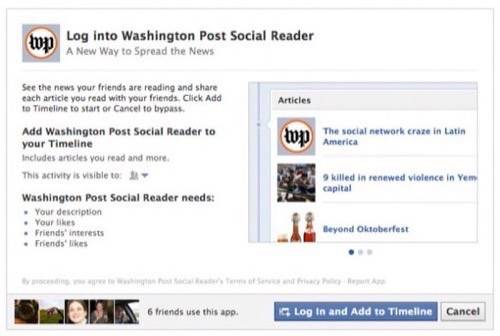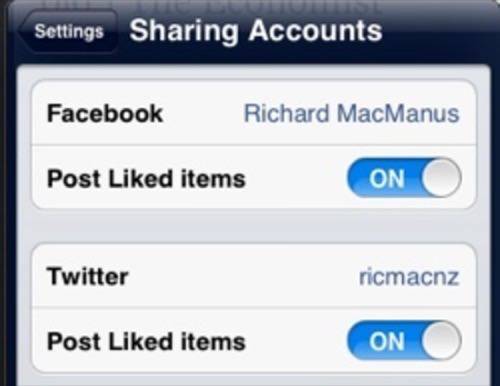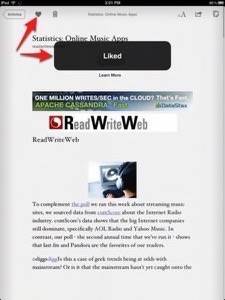Facebook’s new frictionless sharing features are “ruining sharing,” according to a thought provoking article by CNET’s Molly Wood. In response, our own Marshall Kirkpatrick argued that Facebook’s seamless sharing is badly implemented and flat out “wrong.”

Both made great points, but ultimately I don’t believe that frictionless sharing is a bad concept. What’s more, I disagree that it has ruined sharing. What Facebook has done is re-define sharing. I think it was an ingenious move and I predict that soon Facebook’s seamless sharing will be the norm.
When Facebook first announced “frictionless sharing” (the company’s term for it), it positioned it as an extension of sharing. What it’s turned out to be is more like an archive of your consumption habits. If this is sharing, then the word has been re-defined by Facebook. The big question is: is this new type of sharing going to be implemented by the rest of the Web’s leading services? And if so, what are the implications of that?
It’s Sharing Jim, But Not As We Know It…
First let’s address the question of whether Facebook’s frictionless sharing is, in fact, sharing as we have come to understand it on the Web. Sharing content with your social network was in many ways the backbone of the so-called Web 2.0 revolution. Think of services like YouTube (sharing videos), Delicious (sharing articles), Flickr (sharing photos) and even the first generation Facebook (sharing status updates with friends).
Yet Molly Wood concluded her article by stating that “frictionless sharing via Open Graph recasts Facebook’s basic purpose, making it more about recommending and archiving than about sharing and communicating.” She made a great point, because the effect of frictionless sharing is to provide an archive of you and your friends’ consumption patterns. However, it is in fact both archiving and sharing.
If you installed the Washington Post Facebook app and gave it permission to publish what you read, then everything that you read on Washington Post (while logged into Facebook) is announced in your Facebook news feed. For example, “Bob Bobson read [article on Washington Post].” But wait, you may argue, Bob didn’t manually share anything. All he did was read it and Facebook shared it on his behalf. But Bob gave Facebook permission to do that, when he installed the Washington Post app. So, effectively, he did choose to “share” that article into his news feed.
So Facebook has re-defined sharing. It has cunningly merged sharing with archiving.

Why This Will Soon Be The Norm
You can judge for yourself whether this form of sharing is something you’re comfortable with. At this stage, I myself am wary of it. I’ve caught myself second-guessing which articles from the Washington Post I visit, because I know that if I click on something there it will show up in my Facebook news feed. That makes me squeemish. Not because I have anything to hide, but because I haven’t gotten used to the paradigm of everything I consume showing up on Facebook.
It’s really up to Facebook to make sure that I, and millions of others, do get used to it. Especially, since this form of sharing is about to go viral. Let’s look at Instapaper, as an example of an app that may soon have frictionless sharing.
Facebook has stated that it will release an API that will enable any content-based service to have “frictionless sharing” – just like the Washington Post. That means content services, like Instapaper, may soon be sharing everything to Facebook.
Currently, I need to manually click a heart icon within Instapaper to like (and optionally share) an article. In my Instapaper settings, I have it set up that everything I ‘like’ in this manner gets sent to Facebook and Twitter. Although, ironically, for me it only works on Twitter for some reason.

I like this method of sharing, as it allows me to be selective about what I share. But it may eventually be usurped by Facebook’s new definition of sharing.

What’s In It For You?
It’s important to note that you, the user, will always have to give your permission for frictionless sharing to happen. Over time there will be incentives to do that, in the form of value-added services that exist precisely because of seamless sharing. Sure, that’s a rose-colored look at the future of frictionless sharing. But Facebook is well aware that it will need to incentivize its users if it wants this functionality turned on across thousands of content sites.
When I outlined the pros and cons of frictionless sharing at the end of September, when the feature was first introduced in Facebook, I stated that frictionless sharing will come to be seen as a masterful move by Facebook. Content services want to access Facebook’s huge user base and so they will enable this feature. Facebook’s size gives it the ability to make this form of sharing the norm for future generations of Internet users.
That’s not to belittle the very real concerns about over-sharing and privacy, as stated eloquently by Molly and Marshall. But Facebook has identified the immense value in tapping into media consumption patterns and, in frictionless sharing, it has found an ingenious way to capture that data.
Now Facebook’s challenge is to convince its users that some of that value is for the end user. Frictionless sharing is scary, there’s no doubt about it. It’s also not ideally implemented right now. So Facebook has work to do, both on the implementation and to show people the benefits of this new form of sharing.










